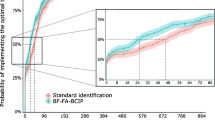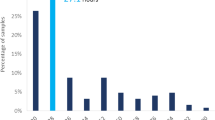Abstract
This study aimed to assess the therapeutic effects of implementing the BioFire® Blood Culture Identification 2 (BCID2) Panel (bioMérieux, Marcy l’Etoile, France) in the clinical practice of children with sepsis. This retrospective cross-sectional study included children from 15 days of age to 18 years old with sepsis and of whom the BCID2 Panel was studied from the positive blood culture. If the antimicrobial treatment was changed according to the results of BCID2 Panel, it was recorded and re-grouped as targeted antimicrobial therapy, de-escalation of the antimicrobial treatment and shifting to another antimicrobial drug if any antimicrobial resistance was detected. Seven-days and thirty-days mortality rate was recorded. Thirty-two patients with 36 septic episodes with positive BCID2 Panel results were included. The median age was 10 months 15 days (ranging from 15 days to 16.5 years). The mean difference between having positive results by the BCID2 Panel and conventional culture methods was 82.2 ± 45.4 h (ranging from 12.3 to 207 h). Effect of the BCID2 Panel on the antimicrobial treatment was detected in 69.4% of the episodes (n = 25). Glycopeptides were ceased at 6 patients, piperacillin/tazobactam was ceased at 6 patients, and cefotaxime was ceased at one patient and de-escalation was achieved in 13 episodes which formed the 36.1% of the initial antimicrobial treatment.
Conclusion: The BCID2 Panel had an important impact on the patients care and optimization according to the principles of antimicrobial stewardship. The BCID2 Panel may be one of the key items for rapid and accurate diagnosis in children with sepsis. Blood culture is still the mainstay for especially detection of antimicrobial drug resistance, while BCID2 tests had several advantages such as speed and diagnostic accuracy as good as blood culture.
What is Known: • The BioFire® Blood Culture Identification 2 (BCID2) Panel (bioMérieux, Marcy l’Etoile, France) is a well-validated assay that allows for the simultaneous identification of 43 nucleic acid targets associated with bloodstream infections within about 1 h. | |
What is New: • BCID2 Panel had a direct impact on the patient’s treatment decision at the 69.4% of the sepsis episodes. • The clinicians received the microbiological results 82.2 h earlier with BCID2 panel compared to blood culture methods with antimicrobial resistance and de-escalation of the antimicrobial drugs was achieved at 13 episodes which formed the 36.1% of the initial treatment. |

Similar content being viewed by others
Availability of data and materials
Data can be accessed upon request to the corresponding author.
Abbreviations
- BCID2 :
-
The BioFire® Blood Culture Identification 2
- SIRS :
-
Systemic inflammatory response syndrome
- PCR :
-
Polymerase Chain Reaction
References
Spaulding AB, Watson D, Dreyfus J et al (2019) Epidemiology of bloodstream infections in hospitalized children in the United States, 2009–2016. Clin Infect Dis 69:995–1002
Weiss SL, Peters MJ, Alhazzani W et al (2020) Surviving sepsis campaign international guidelines for the management of septic shock and sepsis-associated organ dysfunction in children. Pediatr Crit Care Med 21:e52–e106
Barlam TF, Cosgrove SE, Abbo LM et al (2016) Implementing an antibiotic stewardship program: guidelines by the Infectious Diseases Society of America and the Society for Healthcare Epidemiology of America. Clin Infect Dis 62:e51–77
European Centre for Disease Prevention and Control Antimicrobial Stewardship. Available online: https://www.ecdc.europa.eu/en/publications-data/directory-guidance-prevention-and-control/prudent-use-antibiotics/antimicrobial. Accessed 22 Nov 2022
Peri AM, Ling W, Furuya-Kanamori L et al (2022) Performance of BioFire Blood Culture Identification 2 Panel (BCID2) for the detection of bloodstream pathogens and their associated resistance markers: a systematic review and meta-analysis of diagnostic test accuracy studies. BMC Infect Dis 22:794
Caméléna F, Péan de Ponfilly G, Pailhoriès H et al (2023) Multicenter evaluation of the FilmArray Blood Culture Identification 2 Panel for pathogen detection in bloodstream infections. Microbiol Spectr 11:e0254722
El Sherif HM, Elsayed M, El-Ansary MR et al (2022) BioFire FilmArray BCID2 versus VITEK-2 system in determining microbial etiology and antibiotic-resistant genes of pathogens recovered from central line-associated bloodstream infections. Biology (Basel) 11:1573
Altun O, Almuhayawi M, Ullberg M et al (2013) Clinical evaluation of the FilmArray blood culture identification panel in identification of bacteria and yeasts from positive blood culture bottles. J Clin Microbiol 51:4130–4136
Rule R, Paruk F, Becker P et al (2021) Diagnostic accuracy of the BioFire FilmArray blood culture identification panel when used in critically ill patients with sepsis. J Microbiol Methods 189:106303
Senok A, Dabal LA, Alfaresi M et al (2023) Clinical impact of the BIOFIRE Blood Culture Identification 2 Panel in adult patients with bloodstream infection: a multicentre observational study in the United Arab Emirates. Diagnostics (Basel) 13:2433
Graff KE, Palmer C, Anarestani T et al (2021) Clinical impact of the expanded BioFire Blood Culture Identification 2 Panel in a U.S. Children's Hospital. Microbiol Spectr 9:e0042921
Messacar K, Hurst AL, Child J et al (2017) Clinical impact and provider acceptability of real-time antimicrobial stewardship decision support for rapid diagnostics in children with positive blood culture results. J Pediatric Infect Dis Soc 6:267–274
Mathias B, Mira JC, Larson SD (2016) Pediatric sepsis Curr Opin Pediatr 28(3):380–387. https://doi.org/10.1097/MOP.0000000000000337. PMID: 26983000; PMCID: PMC4913352
Weiss SL, Fitzgerald JC, Balamuth F, Alpern ER, Lavelle J, Chilutti M, Grundmeier R, Nadkarni VM, Thomas NJ (2014) Delayed antimicrobial therapy increases mortality and organ dysfunction duration in pediatric sepsis. Crit Care Med 42(11):2409–2417. https://doi.org/10.1097/CCM.0000000000000509. PMID: 25148597; PMCID: PMC4213742
Holma T, Torvikoski J, Friberg N et al (2022) Rapid molecular detection of pathogenic microorganisms and antimicrobial resistance markers in blood cultures: evaluation and utility of the next-generation FilmArray Blood Culture Identification 2 panel. Eur J Clin Microbiol Infect Dis 41:363–371
Peri AM, Bauer MJ, Bergh H et al (2022) Performance of the BioFire Blood Culture Identification 2 panel for the diagnosis of bloodstream infections. Heliyon 8:e09983
Sparks R, Balgahom R, Janto C et al (2021) Evaluation of the BioFire Blood Culture Identification 2 panel and impact on patient management and antimicrobial stewardship. Pathology 53:889–895
Verroken A, Despas N, Rodriguez-Villalobos H et al (2019) The impact of a rapid molecular identification test on positive blood cultures from critically ill with bacteremia: a pre-post intervention study. PLoS ONE 14:e0223122
Payne M, Champagne S, Lowe C et al (2018) Evaluation of the FilmArray Blood Culture Identification Panel compared to direct MALDI-TOF MS identification for rapid identification of pathogens. J Med Microbiol 67:1253–1256
Pardo J, Klinker KP, Borgert SJ et al (2016) Clinical and economic impact of antimicrobial stewardship interventions with the FilmArray blood culture identification panel. Diagn Microbiol Infect Dis 84:159–164
Timbrook TT, Morton JB, McConeghy KW et al (2017) The effect of molecular rapid diagnostic testing on clinical outcomes in bloodstream infections: a systematic review and meta-analysis. Clin Infect Dis 64:15–23
Forrest GN, Mehta S, Weekes E et al (2006) Impact of rapid in situ hybridization testing on coagulase-negative staphylococci positive blood cultures. J Antimicrob Chemother 58:154–158
Author information
Authors and Affiliations
Contributions
All authors contributed to the study conception and design. Material preparation and data collection were performed by Fahri Yuce Ayhan, Pelin Kacar, Gizem Guner Ozenen, Arzu Bayram, Deniz Ergun, Hincal Ozbakir, Miray Yilmaz Celebi, Mustafa Gulderen, Aybuke Akaslan Kara, Arife Ozer, Nuri Bayram. Analysis were performed by Ilker Devrim. The first draft of the manuscript was written by Ilker Devrim and all authors commented on previous versions of the manuscript. All authors read and approved the final manuscript.
Corresponding author
Ethics declarations
Ethics approval
This study was performed in line with the principles of the Declaration of Helsinki. Approval was granted by the Ethics Committee of the Local Ethical Committee of Dr. Behcet Uz Children's Training and Research Hospital.
Consent to participate
Informed consent was obtained from all individual participants included in the study.
Competing interests
The authors declare no competing interests.
Additional information
Communicated by Tobias Tenenbaum
Publisher's Note
Springer Nature remains neutral with regard to jurisdictional claims in published maps and institutional affiliations.
Rights and permissions
Springer Nature or its licensor (e.g. a society or other partner) holds exclusive rights to this article under a publishing agreement with the author(s) or other rightsholder(s); author self-archiving of the accepted manuscript version of this article is solely governed by the terms of such publishing agreement and applicable law.
About this article
Cite this article
Devrim, I., Ayhan, F.Y., Kacar, P. et al. The impact of the BIOFIRE® Blood Culture Identification 2 Panel on antimicrobial treatment of children with suspected systemic inflammatory response syndrome and sepsis. Eur J Pediatr 183, 1353–1360 (2024). https://doi.org/10.1007/s00431-023-05381-7
Received:
Revised:
Accepted:
Published:
Issue Date:
DOI: https://doi.org/10.1007/s00431-023-05381-7




